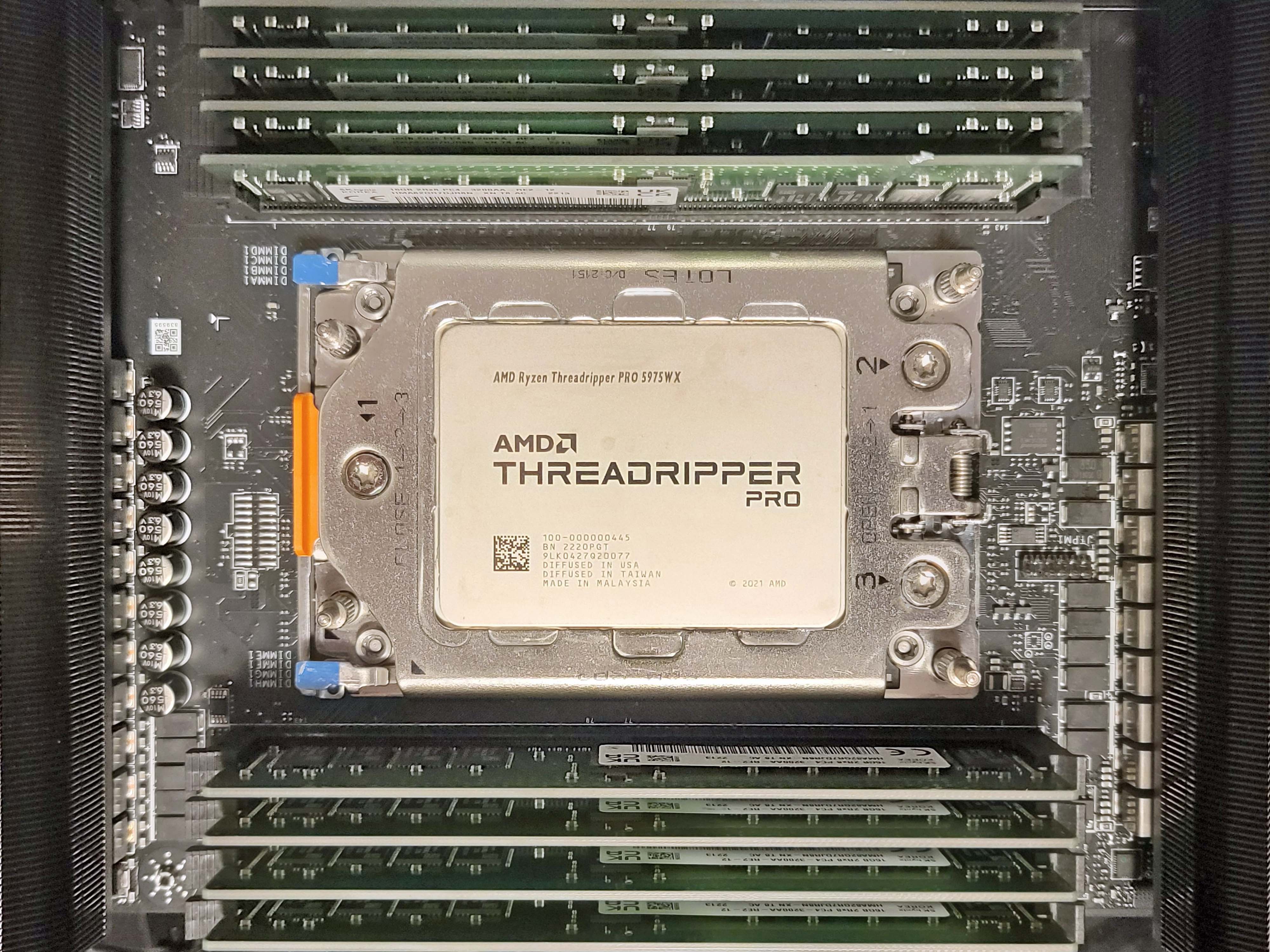Why you can trust Tom's Hardware
Workstation CPU and GPU Benchmarks Test Notes
Some of these applications also make an appearance in our standard test suite, but those test configurations and benchmarks are focused on a typical desktop-class environment. In contrast, the following tests are configured to stress the systems with workstation-class workloads, which is a particular strength for the Threadripper processors given their hefty core counts.
With the exception of the W-3175X and Threadripper Pro systems, we loaded down our test platforms with 64GB of DDR4 memory spread across four modules to accommodate the expanded memory capacity required for several of these workstation-focused tasks. Due to the W-3175X's six-channel memory controller and our limited stock of high-capacity DIMMs, we used six 8GB DIMMs for a total capacity of 48GB. As mentioned, we're stuck with testing with 128GB of DDR4-3200 ECC memory for the Threadripper Pro chips - and at JEDEC timings.
SPECviewperf 2020 GPU Benchmarks on AMD Threadripper Pro 5995WX and 5975WX
The SPECviewperf 2020 benchmarks show how well the Threadripper Pro processors can push along an Nvidia GeForce RTX 3090 in professional rendering applications. This has long been a weakness of previous-gen Threadripper processors, but the Zen 3 5000-series models build on the improvements we saw with the Zen 2 3000-series.
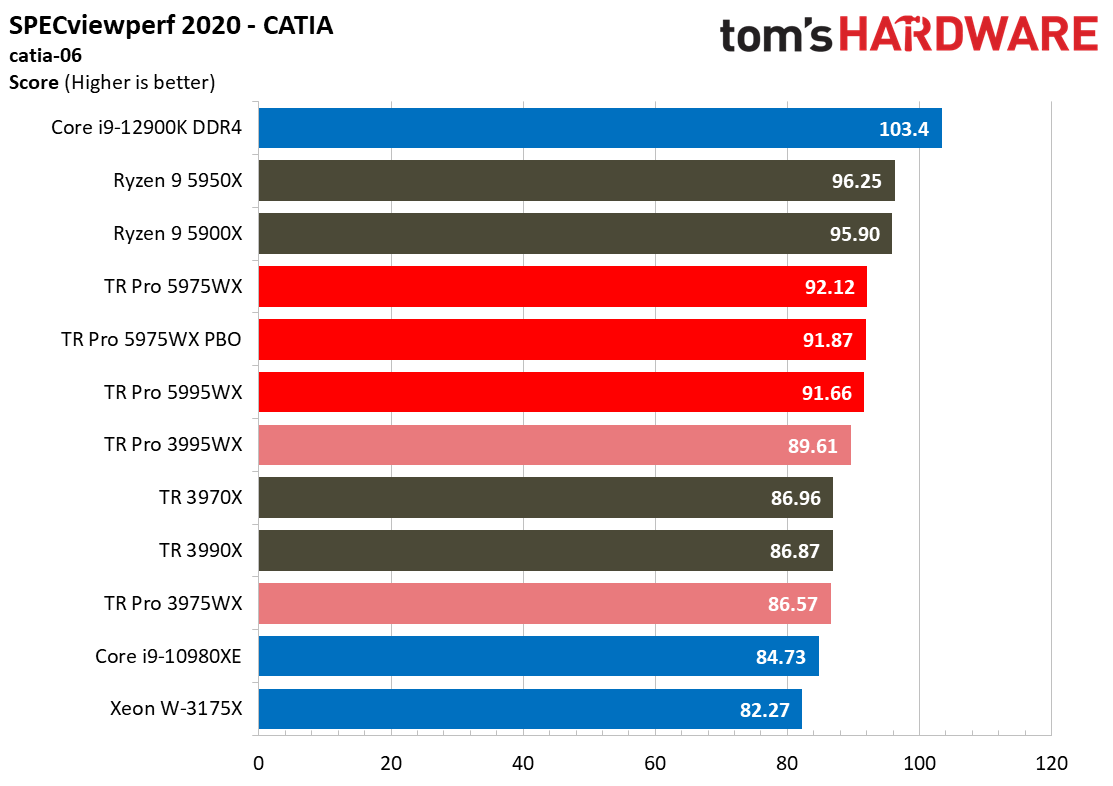
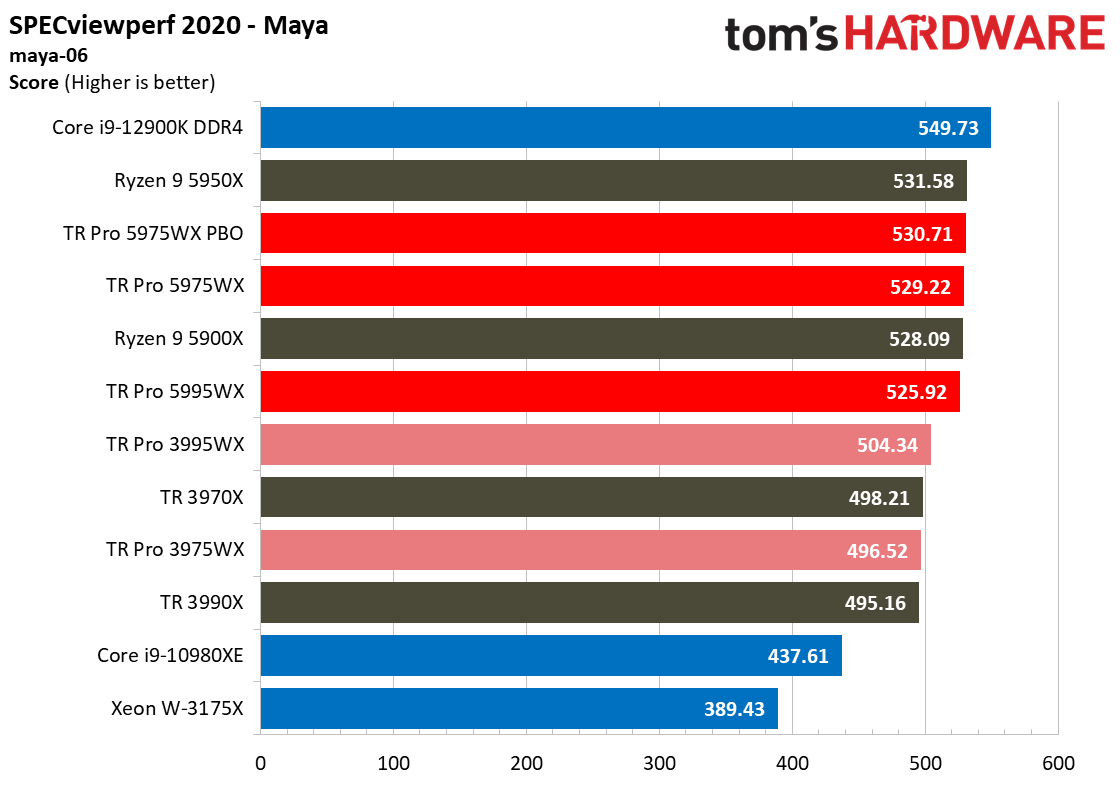
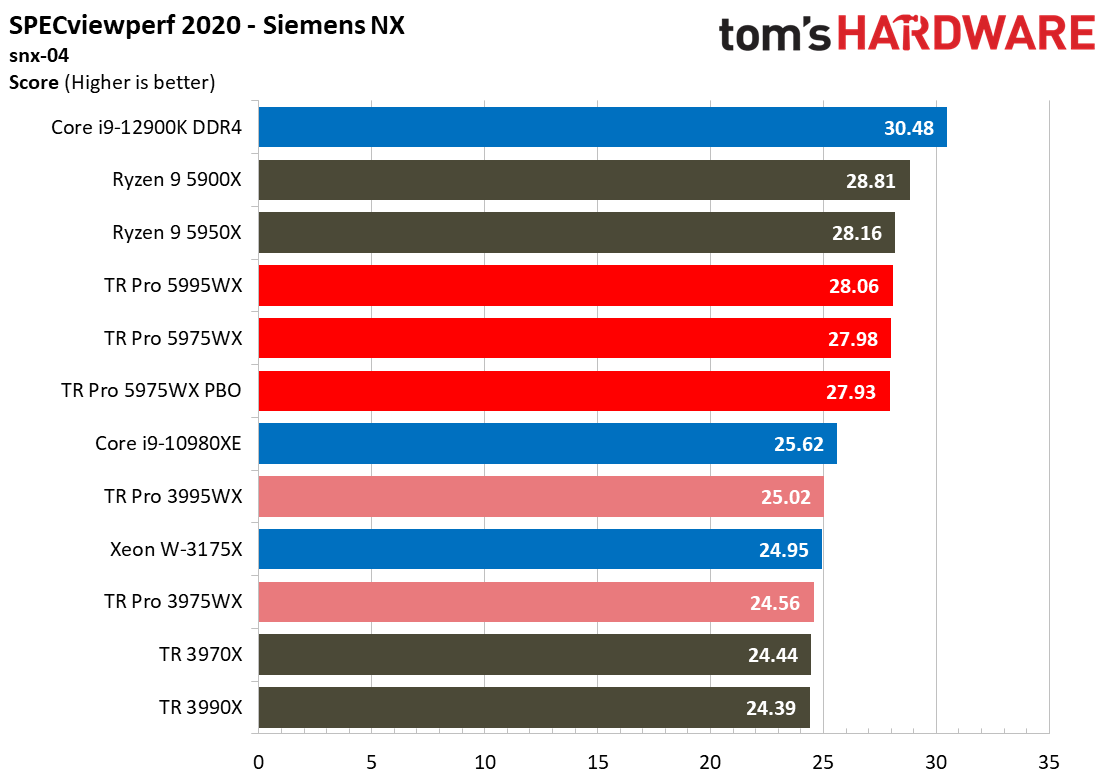

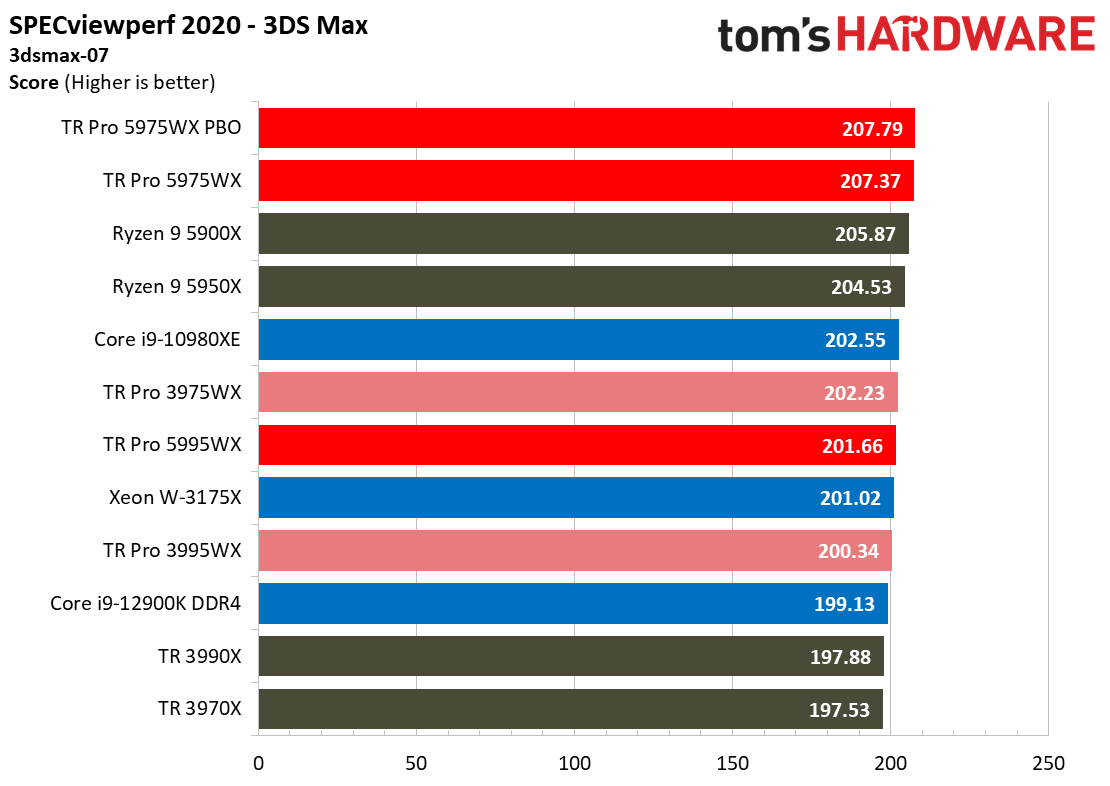

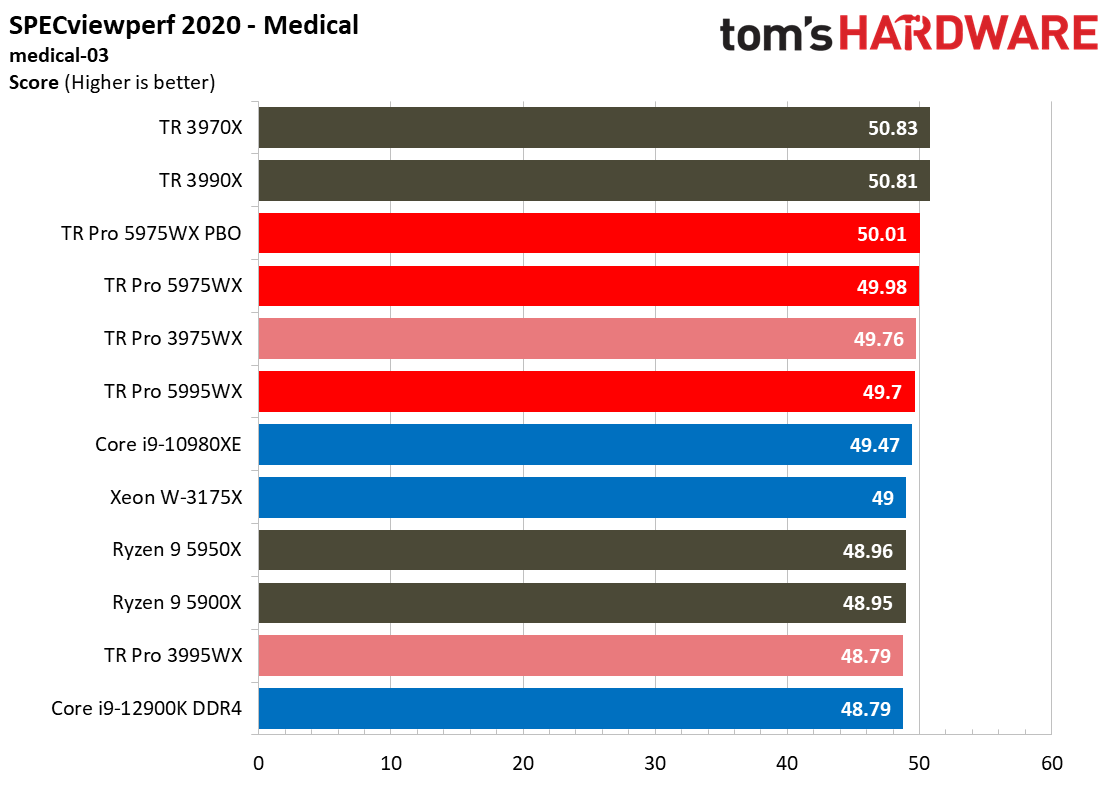
- The following short descriptions are from the SPEC committee. Each entry has a link to more detailed test descriptions on the SPEC website.
- 3ds max-07 - Autodesk 3ds Max 2016 - 11 tests representing rendering modes used in gaming, film visual effects, and architectural markets.
- maya-06 - Autodesk Maya 2017 - 10 rendering tests, including shaded, ambient occlusion, multi-sample anti-aliasing, and transparency.
- catia-06 - Dassault Systems Catia v5 / 3DExperience - 10 tests ranging from 2.1 to 21 million vertices. Viewsets include several rendering modes - anti-aliasing, shaded, and shaded with edges.
- solidworks-05 - Dassault Systems Solidworks 2020 - 10 tests ranging from 2.1 to 21 million vertices. Viewsets include several rendering modes - shaded, shaded with edges, ambient occlusion, shaders, and environment maps.
- energy-03 - OpendTect seismic visualization - 3D tests based on real-world seismic datasets.
- medical-03 - 2D slice rendering and raycasting techniques found in medical applications.
- creo-03 - Creo 4 - Model sizes range from 20 to 48 million vertices, with multiple rendering modes.
- snx-04 - Siemens NX 8.0 - 10 tests ranging from 7.15 to 8.45 million vertices with wireframe, anti-aliasing, shaded, shaded with edges, and studio mode rendering modes.
Per-core performance continues to reign supreme in most graphics-accelerated workloads, so high clock speeds and/or architectures with higher IPC tend to thrive in many of these benchmarks. As such, we see that mainstream desktop PC chips frequently lead, with the Core i9-12900K having a particularly strong showing due to its class-leading performance in single-threaded workloads.
It is important to note that AMD now offers very competitive performance in GPU-accelerated workloads where it had traditionally trailed by large margins with the 1000- and 2000-series chips. However, we don't have any Xeon W-3300 chips on hand for comparison. The Ice Lake architecture does have its benefits in single-threaded work, so we're missing a bit of the competitive landscape in this series of tests.
The desktop PC chips took an easy lead in the Creo, Catia, and Siemens NX workloads, but the 5000-series Threadripper Pro chips beat the other competing chips handily, showing solid generational performance gains in the process. The 32-core 5975WX even took the overall lead in 3DS Max, albeit by a slim margin.
The seismic modeling Energy benchmark and the Medical test sequence show that performance is comparable between the various processors in some of these applications. In those cases, other bottlenecked parts of the workflow become the deciding factor, like CPU compute, storage performance, or other factors.
AMD has steadily improved Threadripper's performance in GPU-accelerated tasks, reducing the deltas between it and competing workstation-class chips (like we saw back in 2017 with the Threadripper 1000 series) to the nearly imperceptible range. Now it has finally taken the lead against the competing workstation chips in our test pool.
Get Tom's Hardware's best news and in-depth reviews, straight to your inbox.
Puget Systems Adobe Benchmarks on AMD Threadripper Pro 5995WX and 5975WX
Puget Systems is a boutique systems vendor that caters to professional users with custom-designed systems targeted at specific workloads. The company has developed a series of acclaimed benchmarks for Adobe software, which you can find here.
Adobe After Effects CC Render Node Benchmark on AMD Threadripper Pro 5995WX and 5975WX
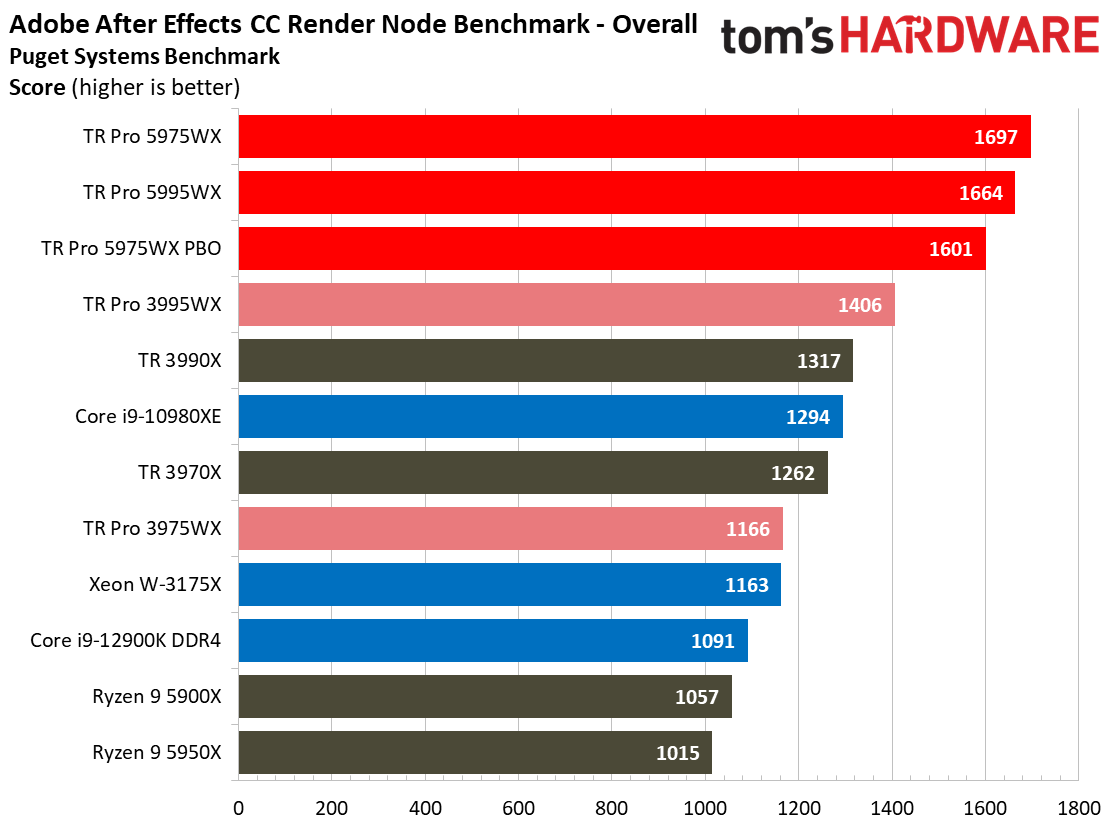
The After Effects render node benchmark leverages the in-built aerender application that splits the render engine across multiple threads to maximize CPU and GPU performance. This test is memory-intensive, so RAM capacity and throughput are important and can be a limiting factor.
Threadripper Pro's improvement here is incredibly impressive — the 5975WX is 45% faster than the prior-gen 3975WX.
However, the 32-core 5975WX beats the 64-core 5995WX in the overall score, so the application has hit a sweet spot at 32 Zen 3 cores. Again, not all applications will fully benefit from the 64-core design. The 64-core 5995WX also doesn't have as much room to stretch its legs within the same 280W TDP as the 64-core 3995WX, so it is 'only' 18% faster in this benchmark. Meanwhile, the Intel chips trail by large margins.
Adobe Premiere Pro CC and Photoshop CC Benchmark on AMD Threadripper Pro 5995WX and 5975WX
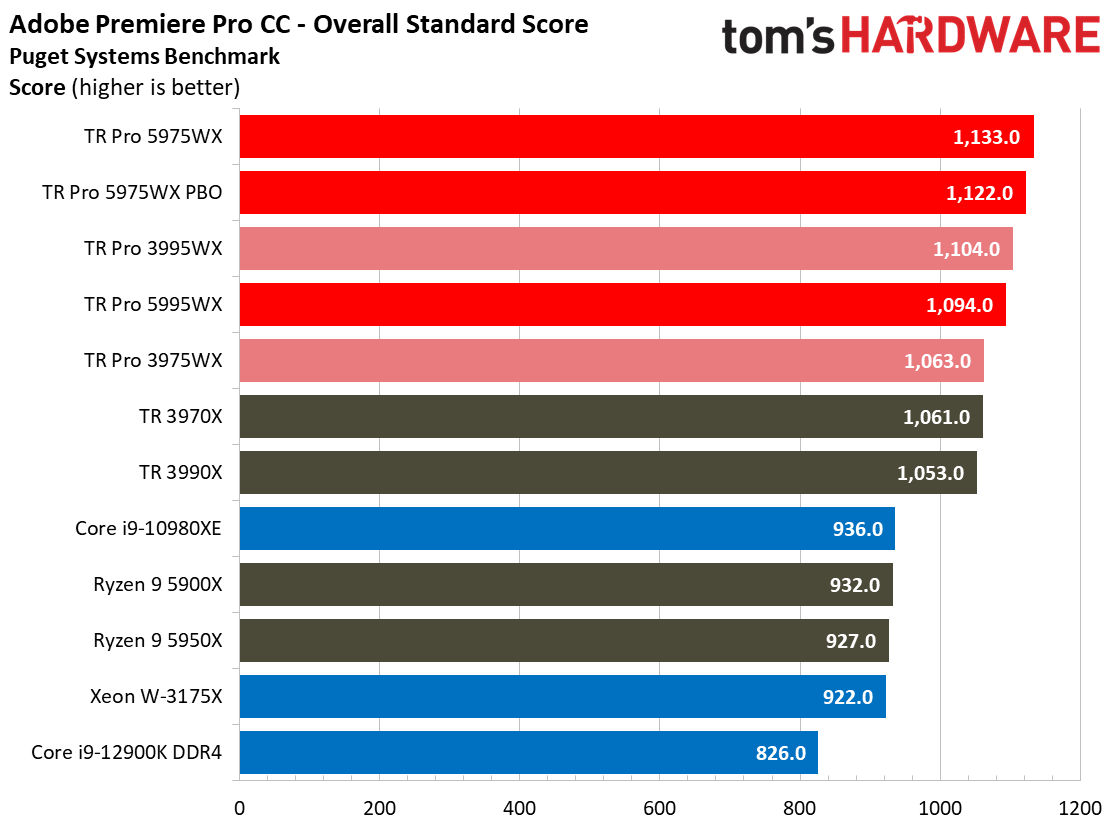


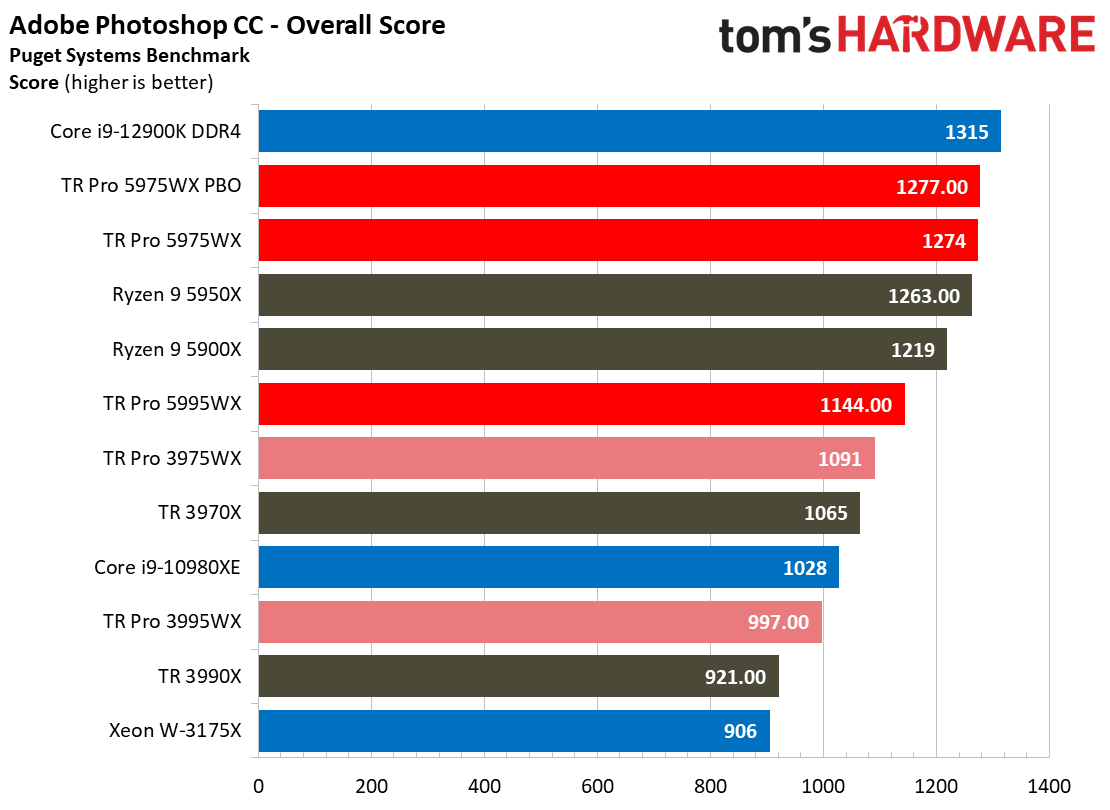
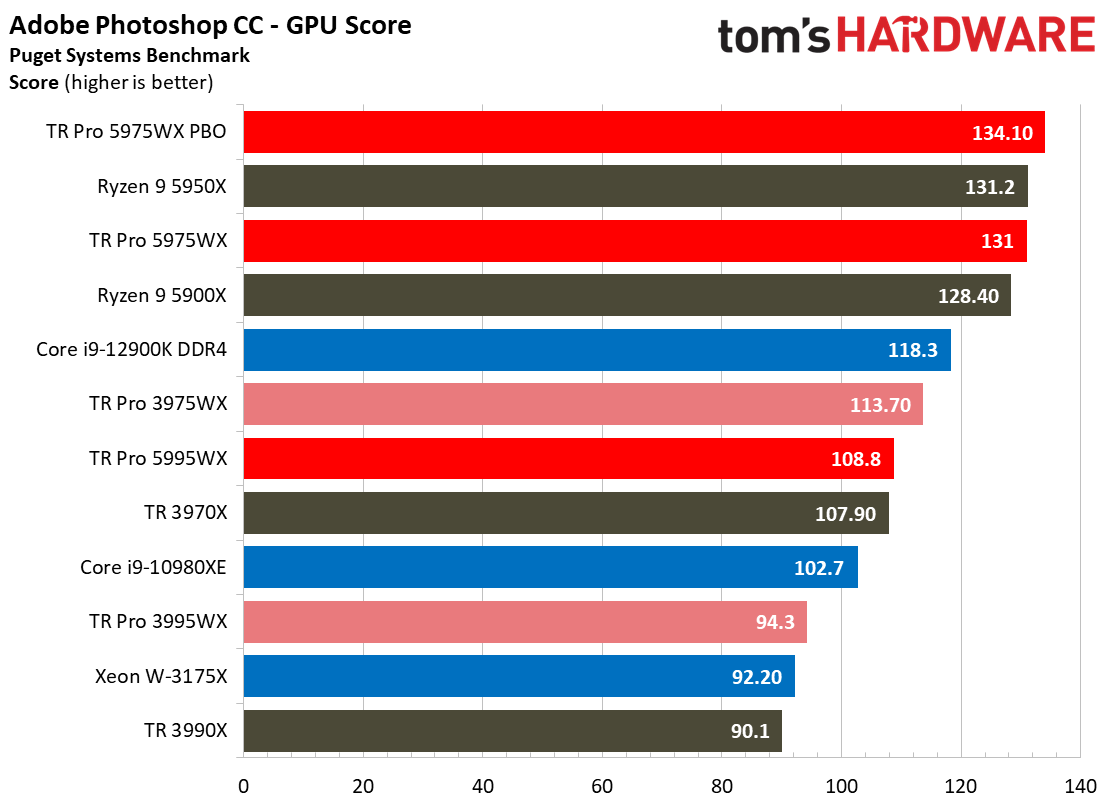
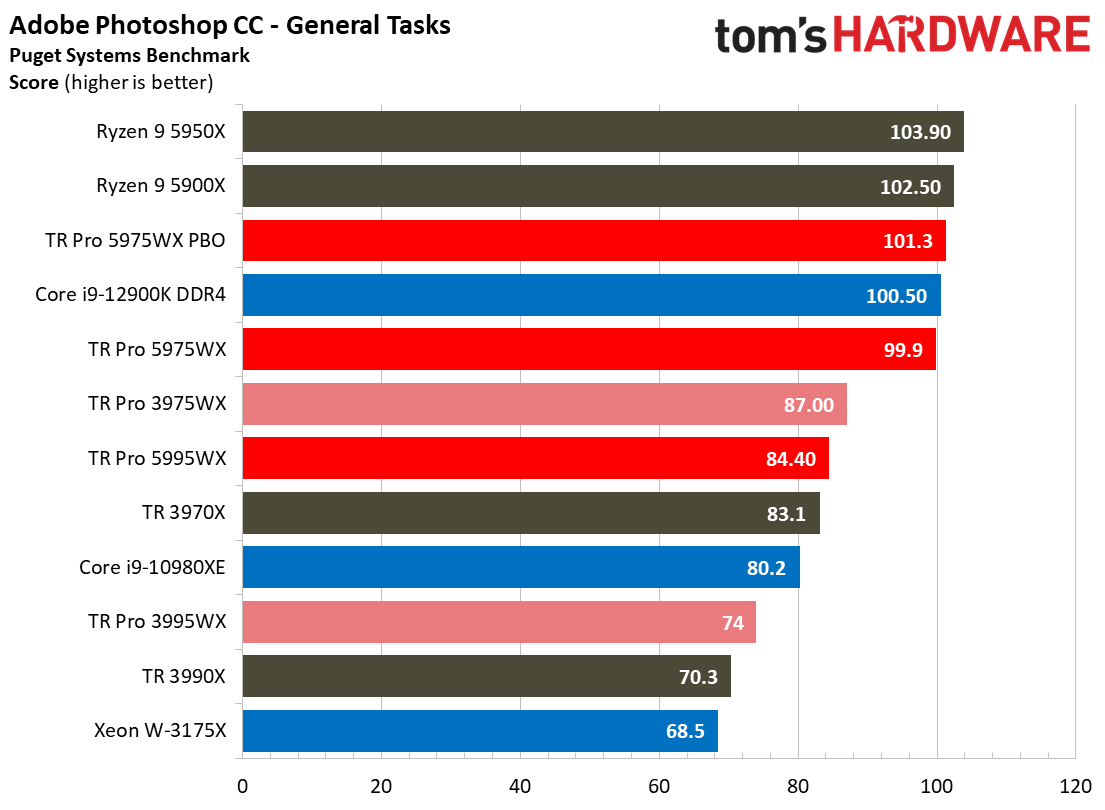

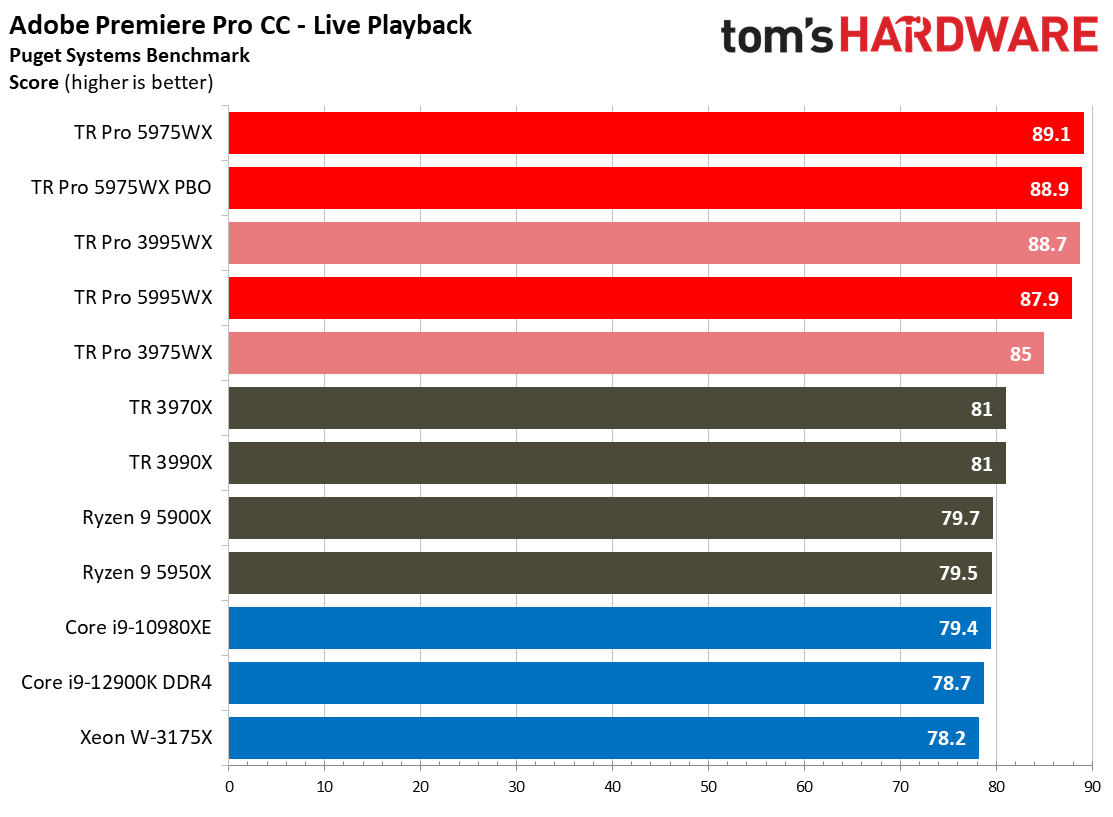
The Premiere Pro benchmark measures live playback and export performance with several codecs at 4K and 8K resolutions. It also incorporates 'Heavy GPU' and 'Heavy CPU' effects that stress the system beyond a typical workload. Storage throughput also heavily impacts the score.
The Threadripper Pro processors are well-suited for this type of work with eight channels of memory throughput and PCIe 4.0 storage accommodations. Threadripper Pro leads the competing Intel chips by huge margins, but the 5995WX trails the previous-gen 3995WX by 1%. The 5975WX is 7% faster than its predecessor, the 3975WX.
The Photoshop benchmark gauges performance in a diverse range of tasks, measuring the time taken to complete general tasks and apply filters. This test leans heavily on GPU acceleration, and it's clear that high clock rates benefit performance tremendously.
The Core i9-12900K takes the lead in the overall score due to its superior per-core performance, but the 32-core 5975WX takes a close second, surprisingly beating the Ryzen 9 processors in this clock-sensitive benchmark.
SPECworkstation 3 Benchmarks on AMD Threadripper Pro 5995WX and 5975WX
The SPECworkstation 3 benchmark suite is designed to measure workstation performance in professional applications. The full suite consists of more than 30 applications split among seven categories, but we've winnowed down the list to tests that largely focus specifically on CPU performance. We haven't submitted these benchmarks to the SPEC organization, so be aware these are not official benchmarks.
Even though the SPECworkstation 3 software supports spanning workloads across multiple processor groups, not all applications can take advantage of the full 128 threads. As such, we're only presenting a few of the CPU-bound tests.
Blender, HandBrake, LuxMark on Threadripper Pro 5995WX and 5975WX

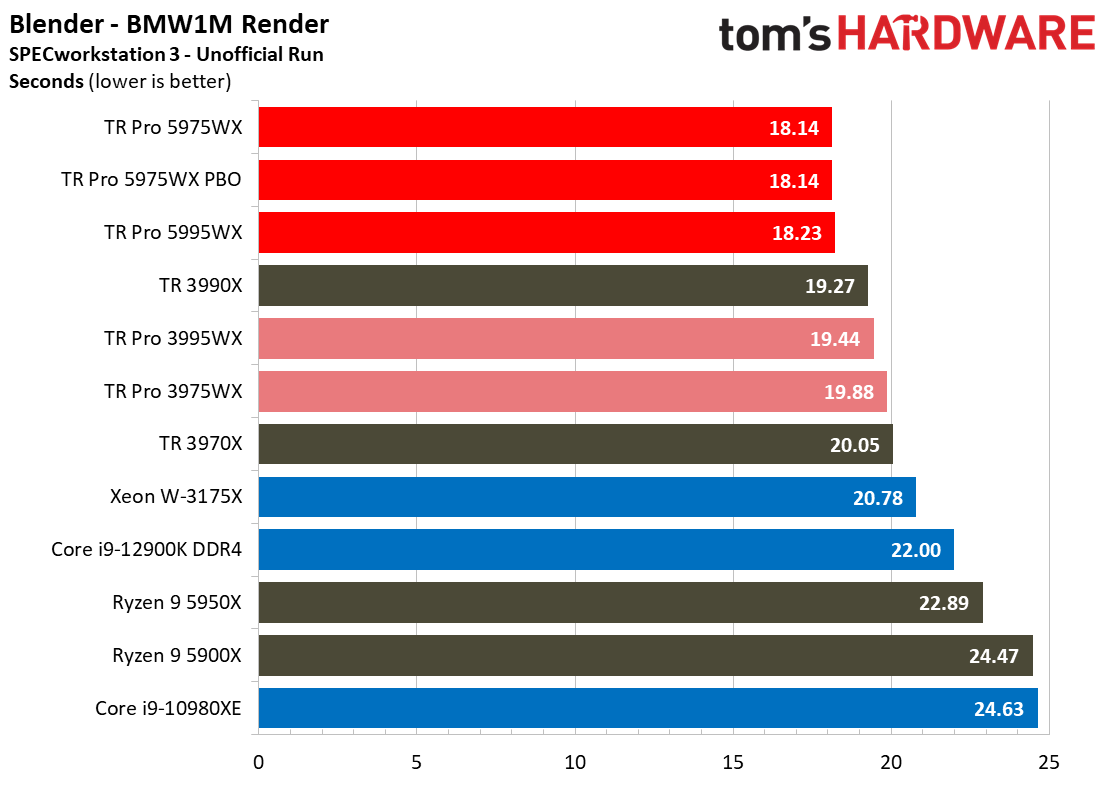
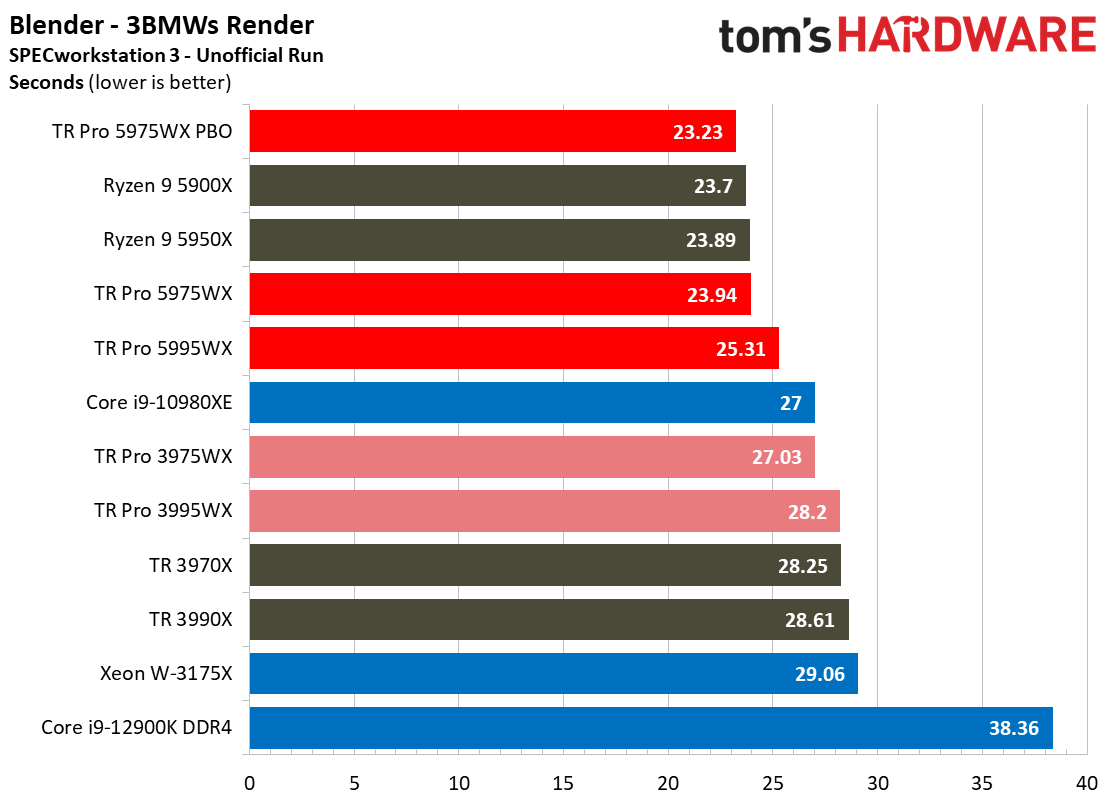

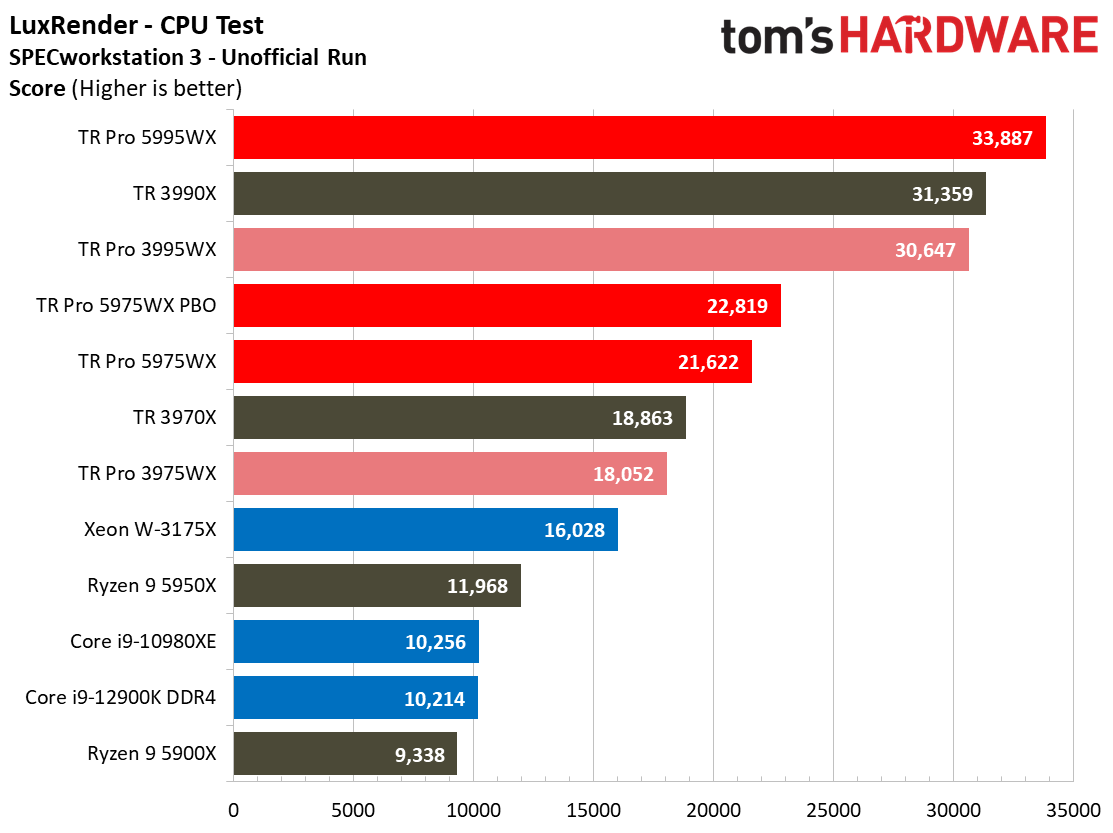

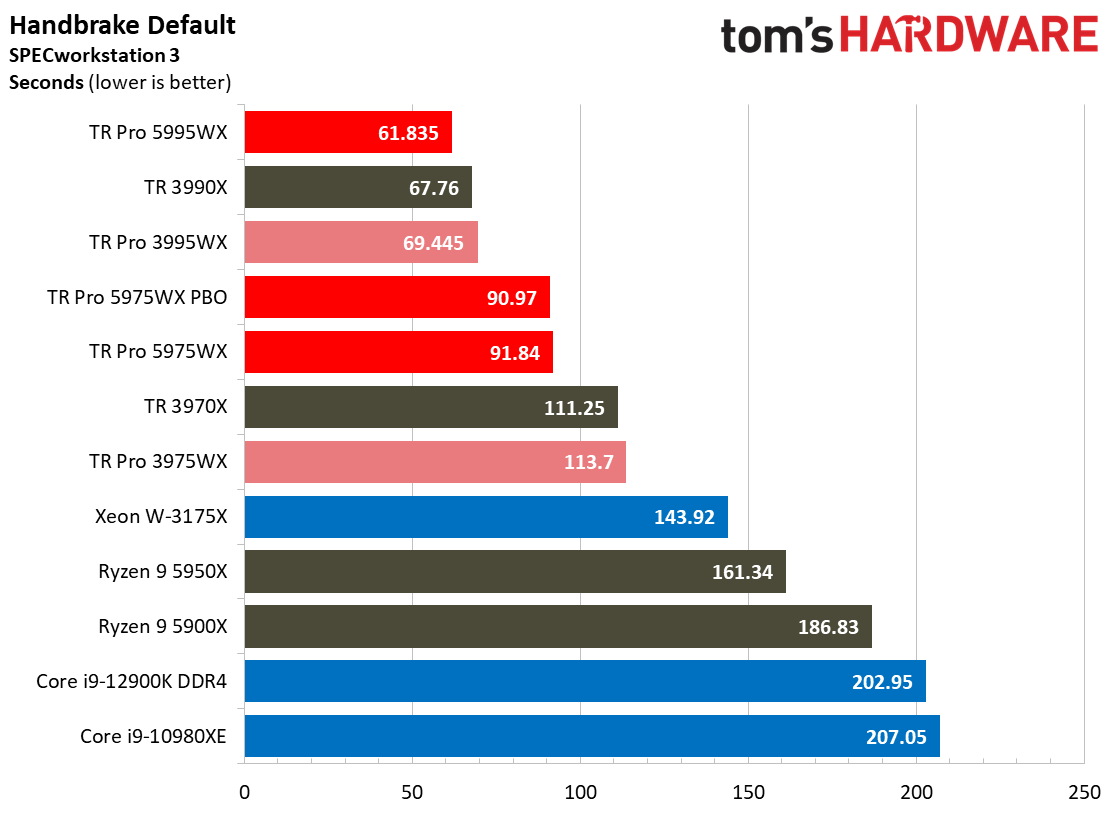
It isn't surprising to see the 5000-series chips lead several of the Blender renders, but the Ryzen 9 chips are impressive in the 3BMWs render. Overall we can see that most of the renders perform best on the 32-core 5975WX, showing that some Blender renders can't extract the full performance of the 64-core 128-thread chips. The 64-core Threadrippers (5995WX, 3995WX, 3990X) all take a substantial lead in the Classroom render, showing that the Blender engine is capable of leveraging the full heft of the chip in some scenarios.
LuxRender shows the full 5995WX being properly utilized — here, the 5995WX is 57% faster than the 5975WX.
The HandBrake tests also expose meaningful performance gains from the 5995WX, with the Zen 3 architecture taking quite the lead over the 32-core Zen 2 processors.
Financial Services, Life Sciences on Threadripper Pro 5995WX and 5975WX
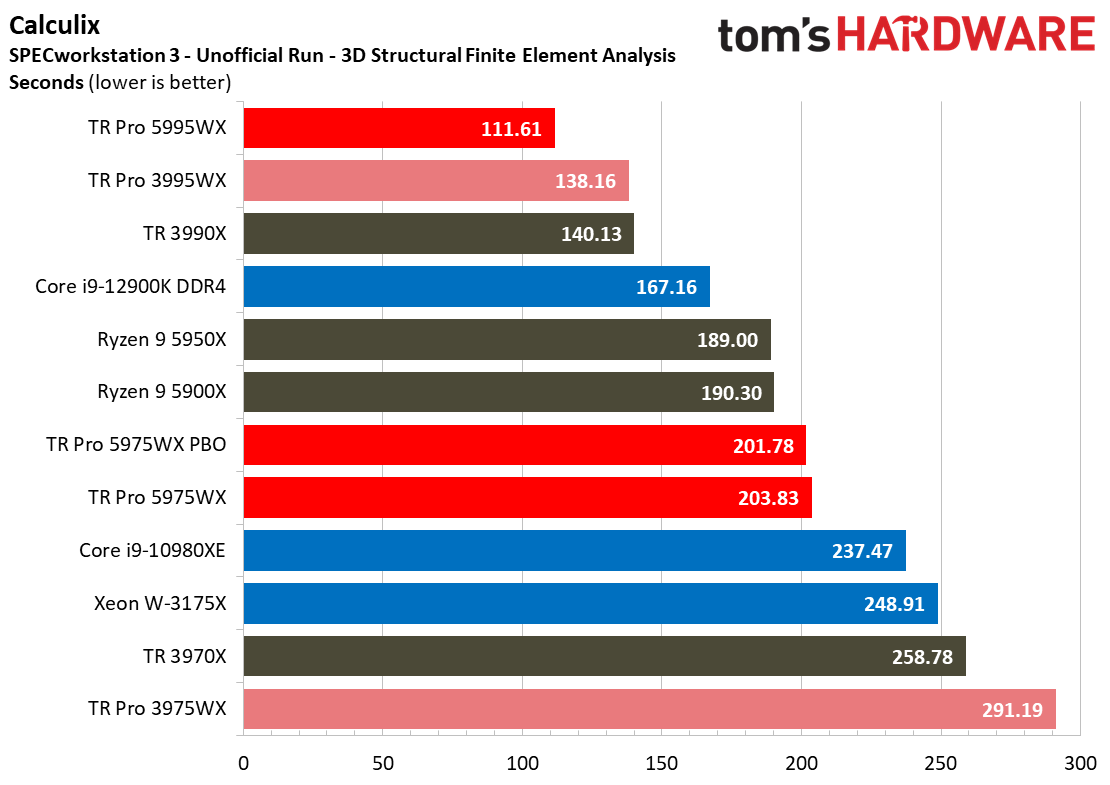
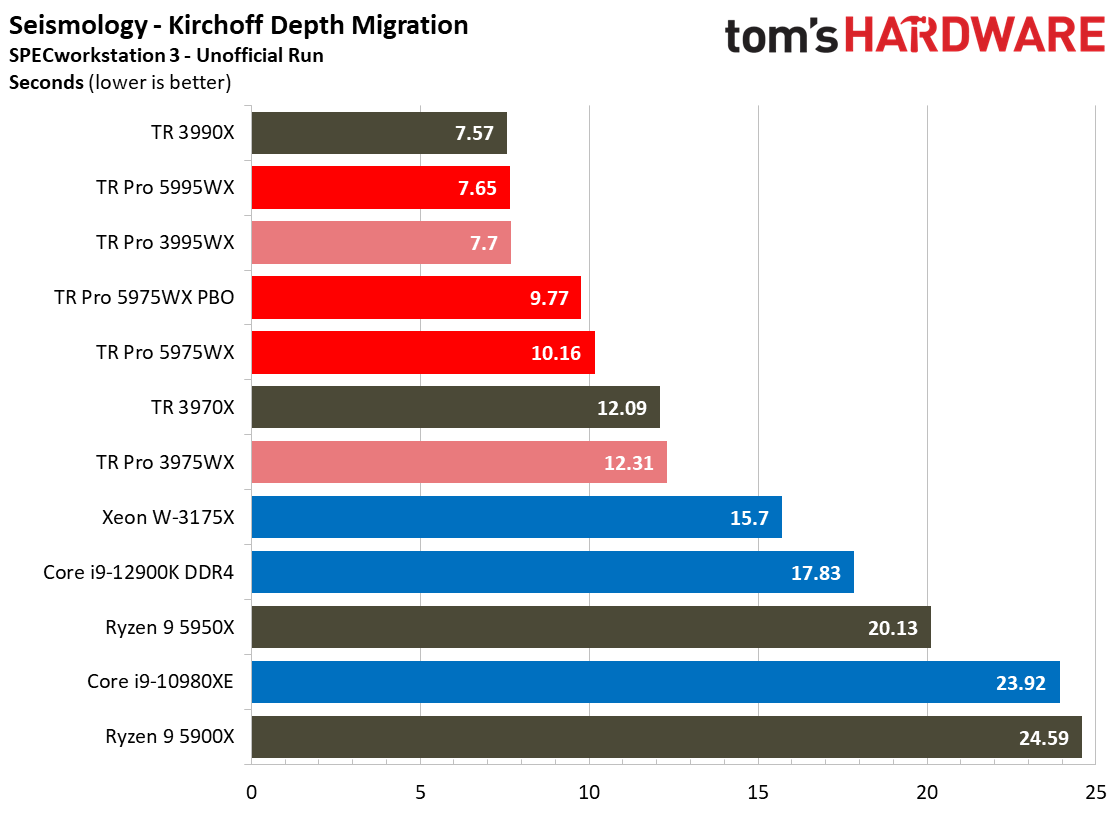
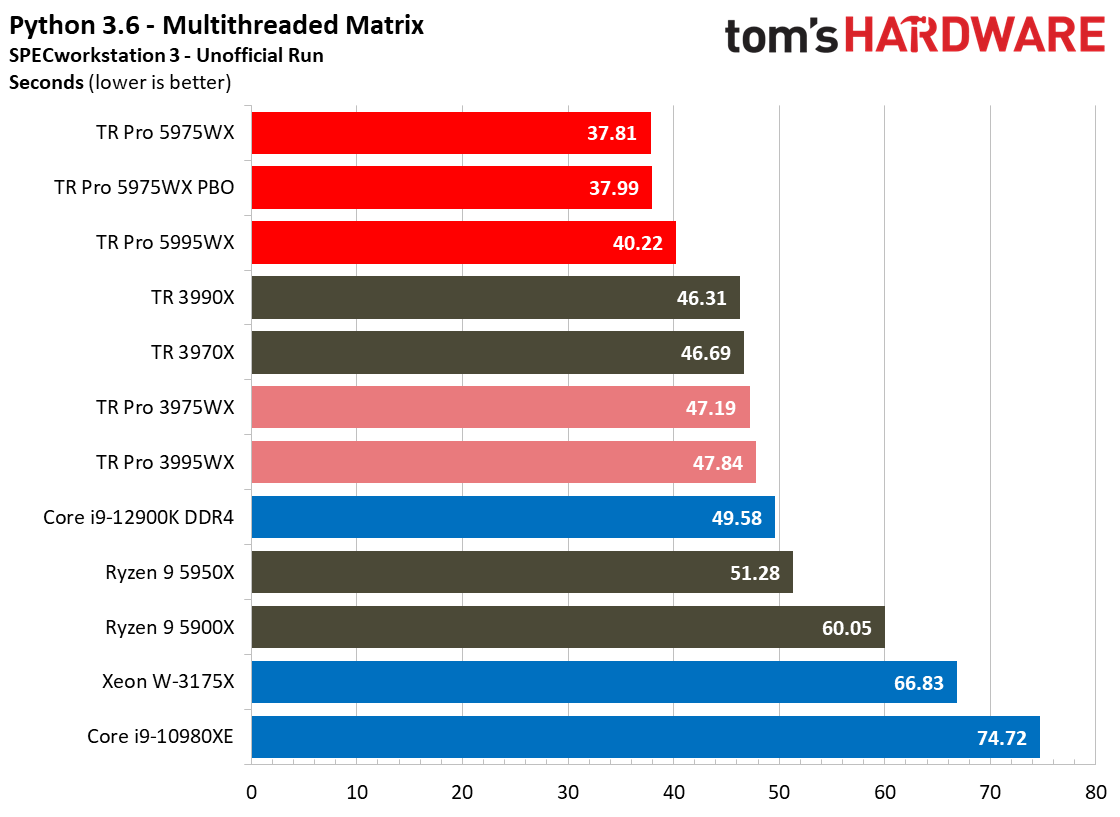
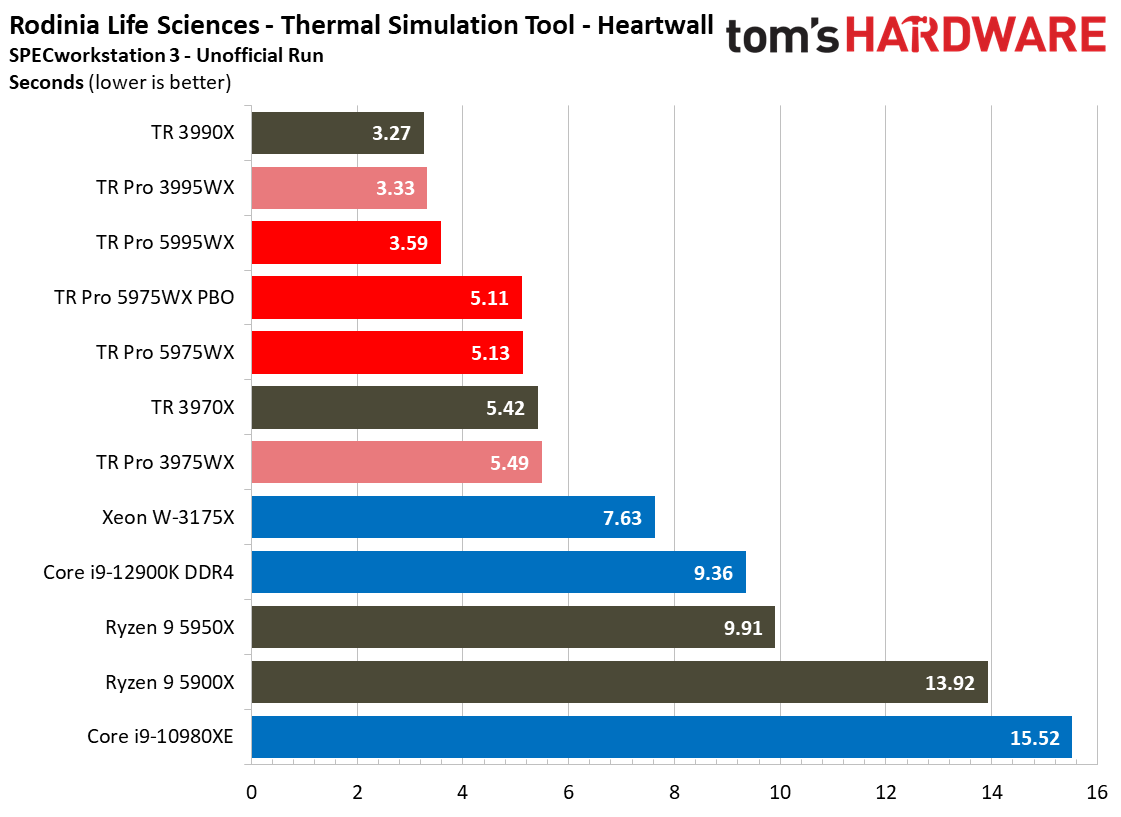
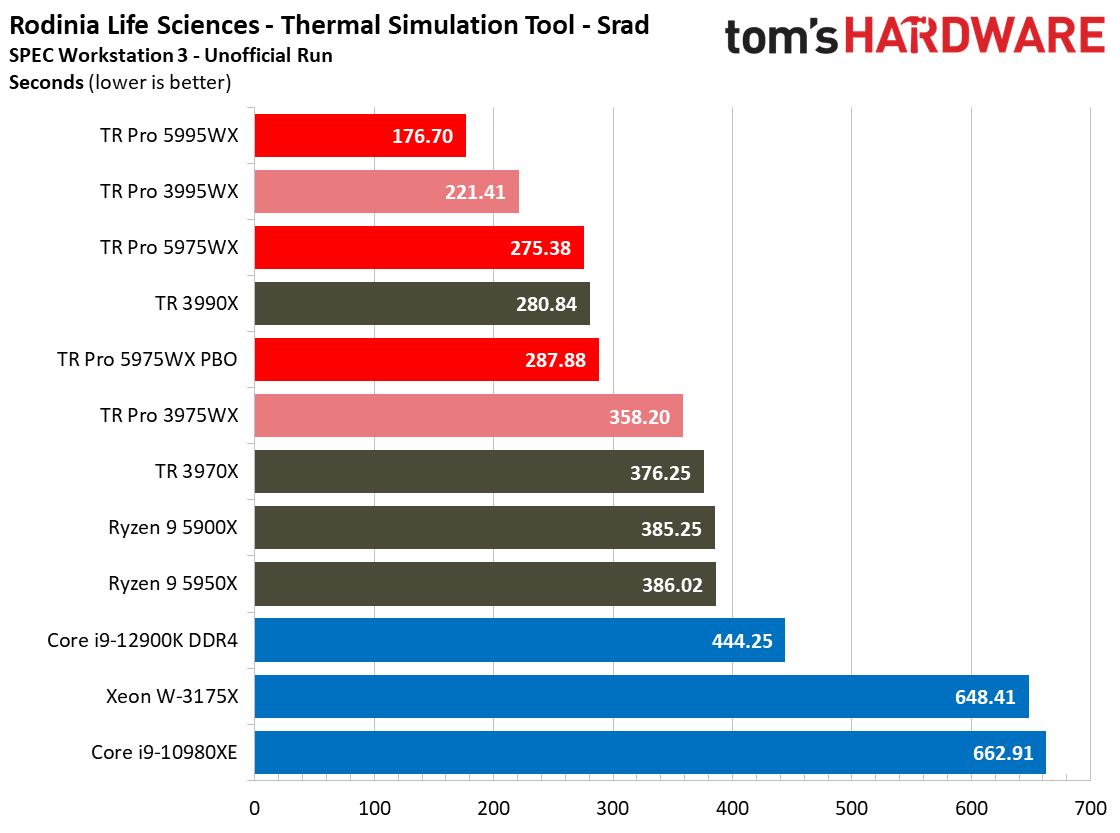
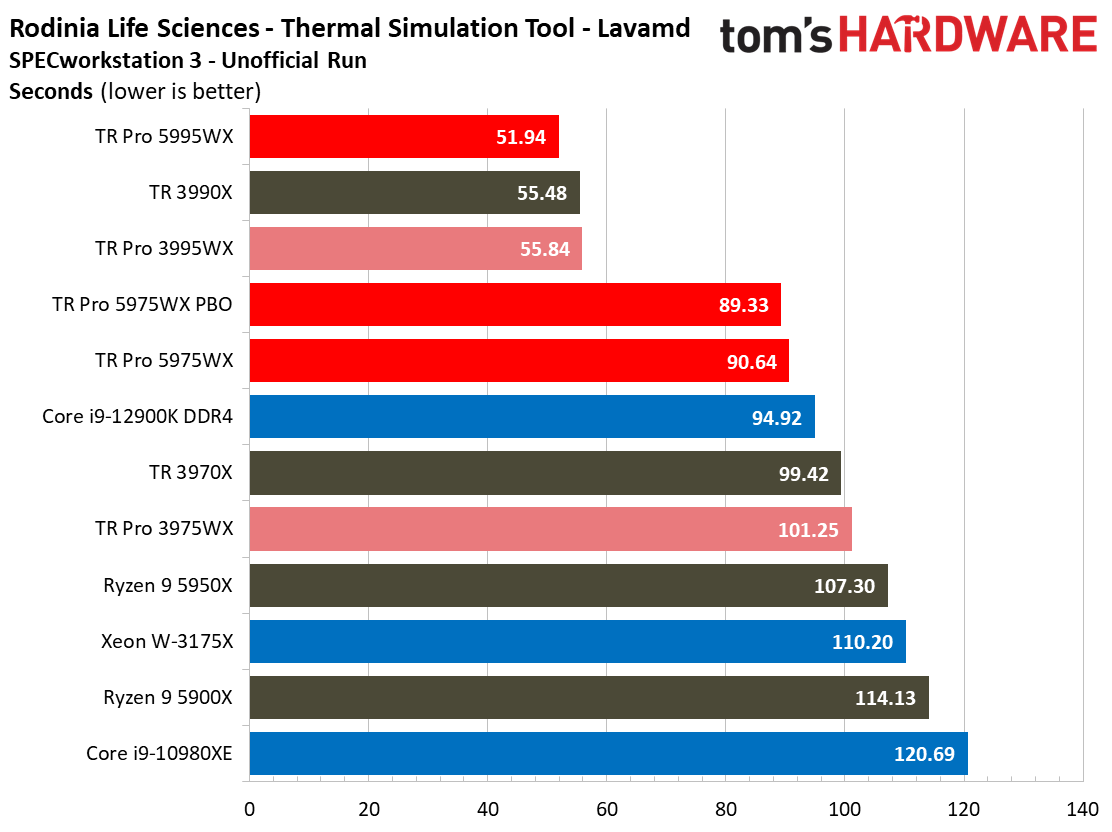
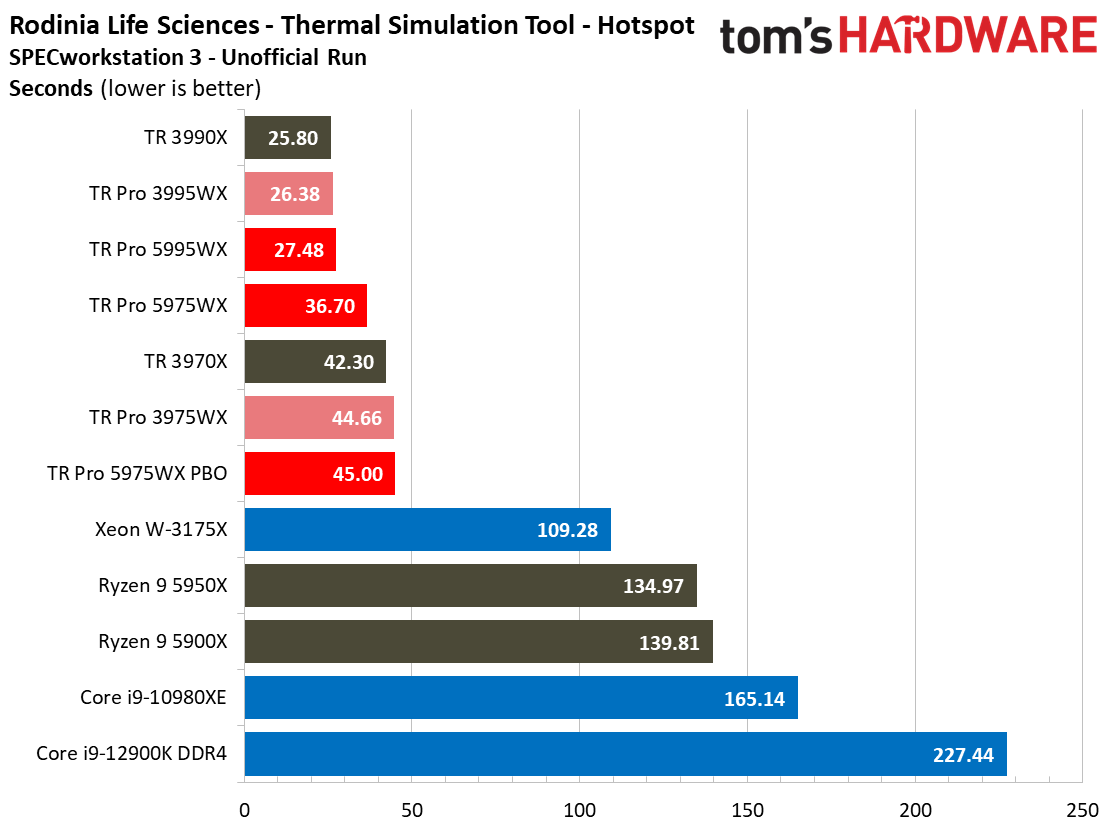

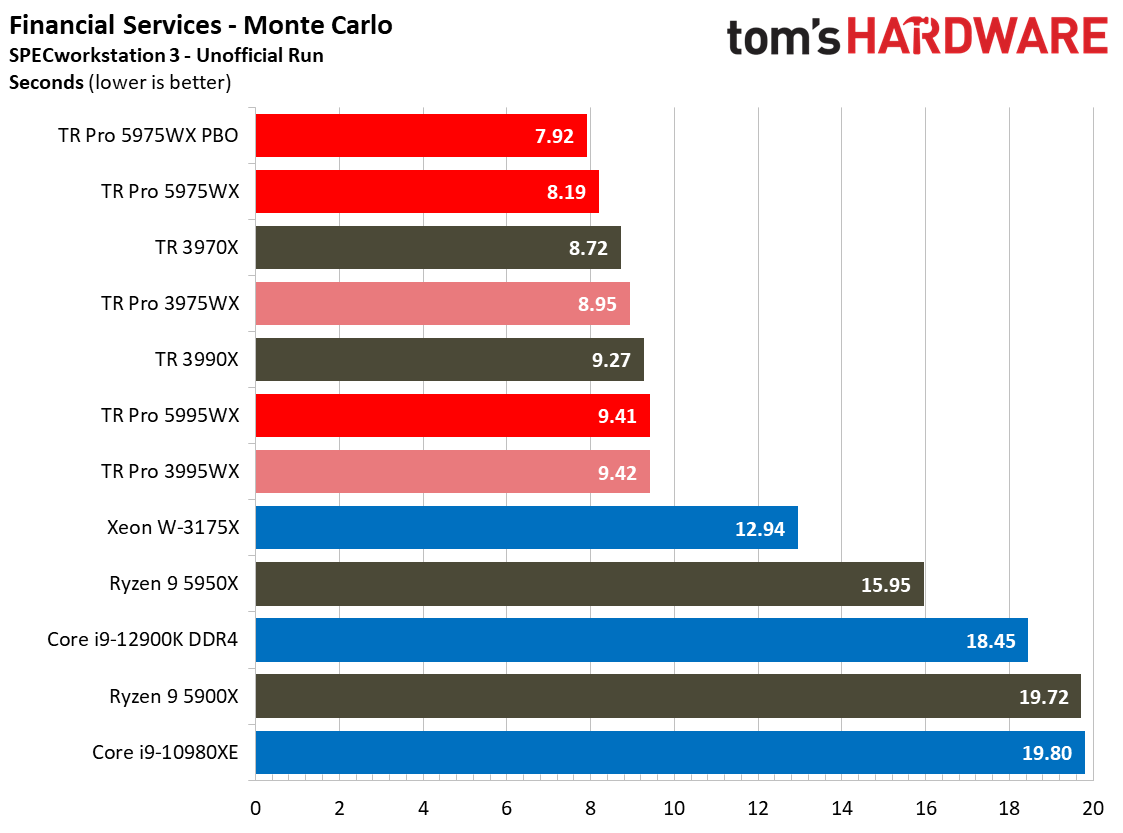
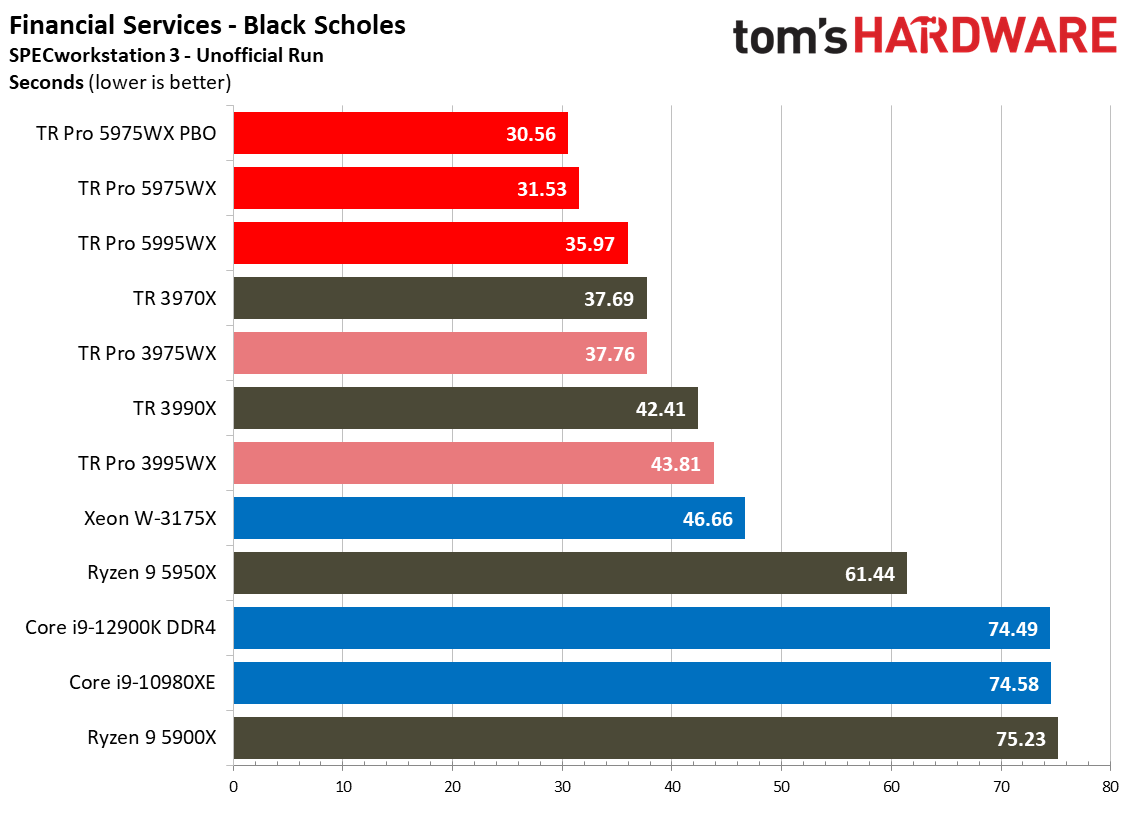
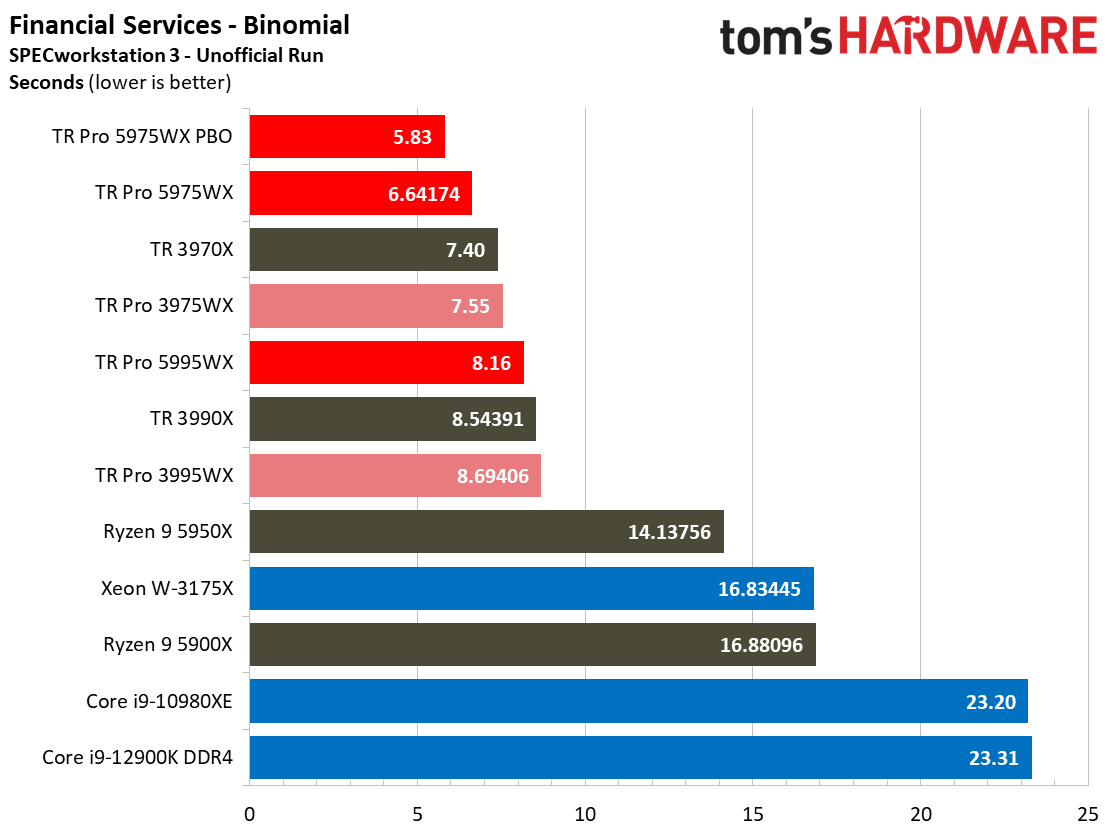
The Calculix workload is based on the finite element method for three-dimensional structural computations, and it typically responds well to both higher core counts and clocks. Once again, the 5995WX is significantly faster than the other 64-core Threadripper models. The 5975WX sees a similar speed-up over the 3975WX, too.
SPECworkstation 3's Rodinia LifeSciences benchmark steps through four tests that include medical imaging, particle movements in a 3D space, a thermal simulation, and image-enhancing programs. The 64-core models dominate the test group.
The earth’s subsurface structure can be determined via seismic processing. One of the four basic steps in this process is the Kirchhoff Migration, which generates an image based on the available data using mathematical operations. Cores reign supreme here as we see the full might of the 5995WX being utilized fully. However, application code and power limits could be limiting factors that hamper the 5995WX's performance scalability, as evidenced by the frequent ties with the previous-gen 64-core models.
- MORE: Best CPUs for Gaming
- MORE: CPU Benchmark Hierarchy
- MORE: AMD vs Intel
- MORE: How to Overclock a CPU
- MORE: How to check CPU Temperature
Current page: Workstation CPU and GPU Benchmarks on Threadripper Pro 5995WX and 5975WX
Prev Page Desktop PC Application Benchmarks on Threadripper Pro 5995WX and 5975WX Next Page A Farewell Ode to HEDT
Paul Alcorn is the Editor-in-Chief for Tom's Hardware US. He also writes news and reviews on CPUs, storage, and enterprise hardware.
-
-Fran- I love the latching mechanism of sWRX8. They should consider using it in consumer as well. I mean, they're already going to ask for a pretty penny on the current one, so why not just make the mechanism the best in the industry?Reply
And this looks quite impressive, specially since these can also do games quite well it seems. I wonder if AMD will ever put a "mini-Milan-X" in sWRX8 for whomever can pay for it? XD
Regards. -
escksu I am hoping tomshardware could test on win11 or server 2022. This is because these 2 OS by default will allow apps to use all available threadsReply
https://docs.microsoft.com/en-us/windows/win32/procthread/processor-groups -
Wisecracker Snagged an OEM ThinkStation P620 Workstation 16 or so months ago from RTP for $2,400 with ...AMD Ryzen TR Pro 3945WXReply
32GB DDR4-3200 RDIMM ECC
Quadro P2200 5GB - 4x DP_1.4
Marvell 10Gb Ethernet
512 GB M.2 Gen 3 PCIe SSDBuilt software RAID with 1TB Samsung SSDs, updated softwares (primarily Vegas Pro) with Canon SLR stuff and fancy appurtenances. Will do a minute -- in 30 seconds.
Other than a !%$@!*^ noisy PSU fan, it has been bulletproof ___ BUT, our good friends at AMD are taking advantage of their captured market. OEM prices easily are up 50% ... -
Sylwah Not a great article: this is a workstation processor and you're leading with gaming benchmarks, and continue to mostly cover gaming.Reply
Then there's the Windows 10/11 discussion.
Please do better next time. -
Guy Rouillier "The problem is AMD has left the two lower-end 12- and 16-core Pro models as OEM-only, so they won't come to retail."Reply
NewEgg has the Threadripper PRO 5955WX available now for $1299:
https://www.newegg.com/amd-ryzen-threadripper-pro-5955wx/p/N82E16819113776
That's a pretty hefty entry price for a home system, but it is available. The quad channel memory of the 3000 series was also better matched to the enthusiast market; only servers and high-end workstations benefit from the 8-channel memory. But I understand AMD's position; they are supply-constrained, so might as well go for the highest-priced markets available. -
This is not an option for home DIY builders, unless they have more money than senseReply
This is a workstation class processor and this is what we use at work on our workstations with tons of RAM and lots of storage so we can run as many virtual machines at once as we need for software development and testing
Threadrippers are all we use. we don’t bother with intel because they have NOTHING to touch it -
Guy Rouillier ReplyMandark said:This is not an option for home DIY builders, unless they have more money than sense
I wouldn't necessarily disagree with that, given the cost of a complete system on this platform. I was also a professional software developer, now retired. The last system I built for myself around 2013, which I'm still using, is a dual AMD Opteron 4234 with 16 GB of memory and all SSD storage. If I were to build a new system today, it would be with Threadripper. Though as I mentioned, for software development 8 memory channels is overkill; 4 really was the sweet spot. I ran our complete runtime environment on my system: a DBMS (Oracle or PostgreSQL), a web server with a JavaEE stack, a JBoss app server, plus all my development tools (Eclipse, etc.)
So, there is still a need for powerful workstation-class systems for individual end-users, but the numbers are small compared to the overall size of the market.
